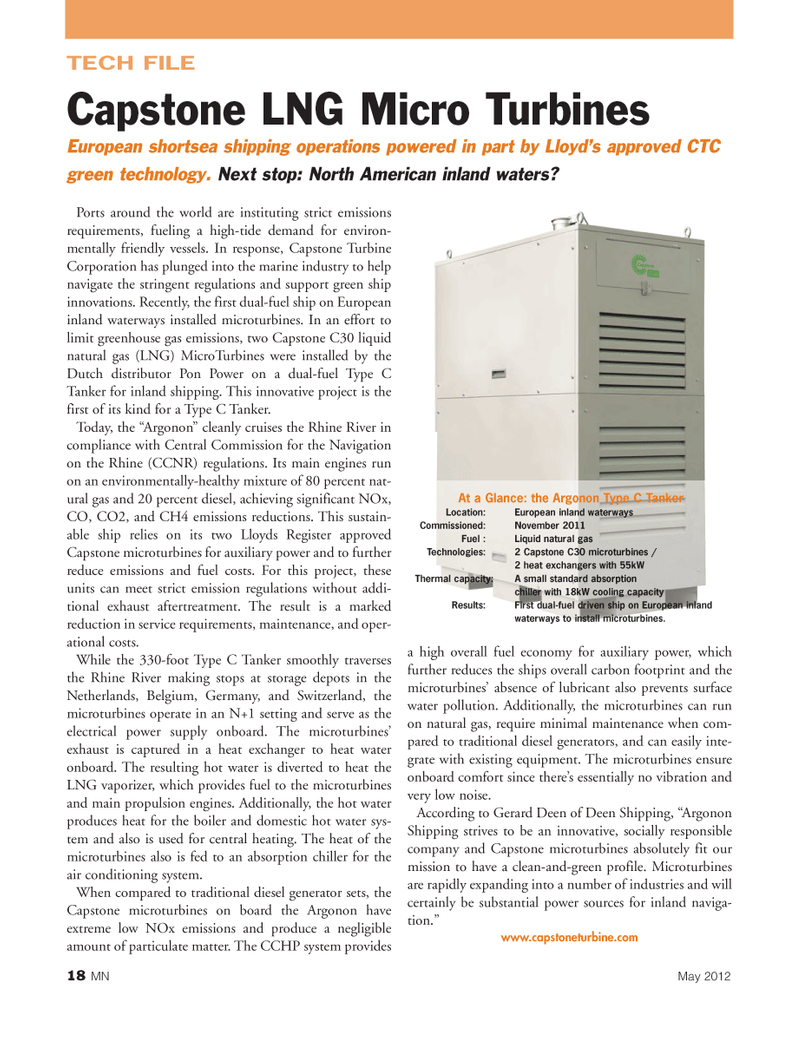
Page 18: of Marine News Magazine (May 2012)
Combat Craft Annual
Read this page in Pdf, Flash or Html5 edition of May 2012 Marine News Magazine
TECH FILECapstone LNG Micro Turbines European shortsea shipping operations powered in part by Lloyd?s approved CTCgreen technology. Next stop: North American inland waters?Ports around the world are instituting strict emissions requirements, fueling a high-tide demand for environ- mentally friendly vessels. In response, Capstone Turbine Corporation has plunged into the marine industry to help navigate the stringent regulations and support green ship innovations. Recently, the first dual-fuel ship on European inland waterways installed microturbines. In an effort to limit greenhouse gas emissions, two Capstone C30 liquid natural gas (LNG) MicroTurbines were installed by the Dutch distributor Pon Power on a dual-fuel Type C Tanker for inland shipping. This innovative project is the first of its kind for a Type C Tanker. Today, the ?Argonon? cleanly cruises the Rhine River in compliance with Central Commission for the Navigation on the Rhine (CCNR) regulations. Its main engines run on an environmentally-healthy mixture of 80 percent nat- ural gas and 20 percent diesel, achieving significant NOx, CO, CO2, and CH4 emissions reductions. This sustain- able ship relies on its two Lloyds Register approved Capstone microturbines for auxiliary power and to further reduce emissions and fuel costs. For this project, these units can meet strict emission regulations without addi- tional exhaust aftertreatment. The result is a marked reduction in service requirements, maintenance, and oper- ational costs.While the 330-foot Type C Tanker smoothly traverses the Rhine River making stops at storage depots in the Netherlands, Belgium, Germany, and Switzerland, the microturbines operate in an N+1 setting and serve as the electrical power supply onboard. The microturbines? exhaust is captured in a heat exchanger to heat water onboard. The resulting hot water is diverted to heat the LNG vaporizer, which provides fuel to the microturbines and main propulsion engines. Additionally, the hot water produces heat for the boiler and domestic hot water sys- tem and also is used for central heating. The heat of the microturbines also is fed to an absorption chiller for the air conditioning system.When compared to traditional diesel generator sets, the Capstone microturbines on board the Argonon have extreme low NOx emissions and produce a negligible amount of particulate matter. The CCHP system provides a high overall fuel economy for auxiliary power, which further reduces the ships overall carbon footprint and the microturbines? absence of lubricant also prevents surface water pollution. Additionally, the microturbines can run on natural gas, require minimal maintenance when com- pared to traditional diesel generators, and can easily inte- grate with existing equipment. The microturbines ensure onboard comfort since there?s essentially no vibration and very low noise. According to Gerard Deen of Deen Shipping, ?Argonon Shipping strives to be an innovative, socially responsible company and Capstone microturbines absolutely fit our mission to have a clean-and-green profile. Microturbines are rapidly expanding into a number of industries and will certainly be substantial power sources for inland naviga- tion.? www.capstoneturbine.com At a Glance: the Argonon Type C Tanker Location: European inland waterways Commissioned: November 2011 Fuel : Liquid natural gas Technologies: 2 Capstone C30 microturbines / 2 heat exchangers with 55kWThermal capacity: A small standard absorption chiller with 18kW cooling capacityResults: First dual-fuel driven ship on European inland waterways to install microturbines. 18MNMay 2012MN#5 (18-31):MN 2011 Layouts 5/7/2012 9:51 AM Page 18

 17
17

 19
19
